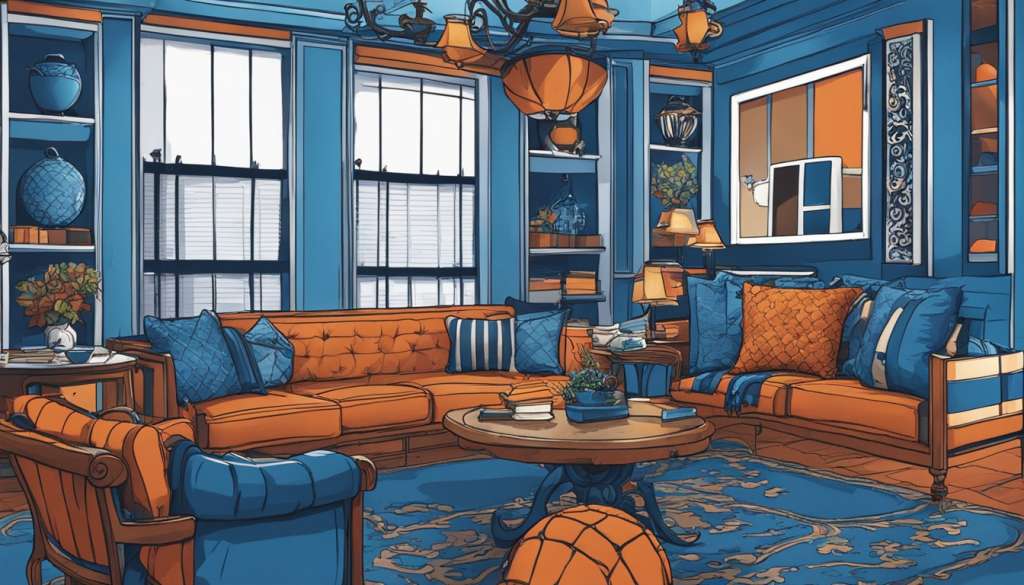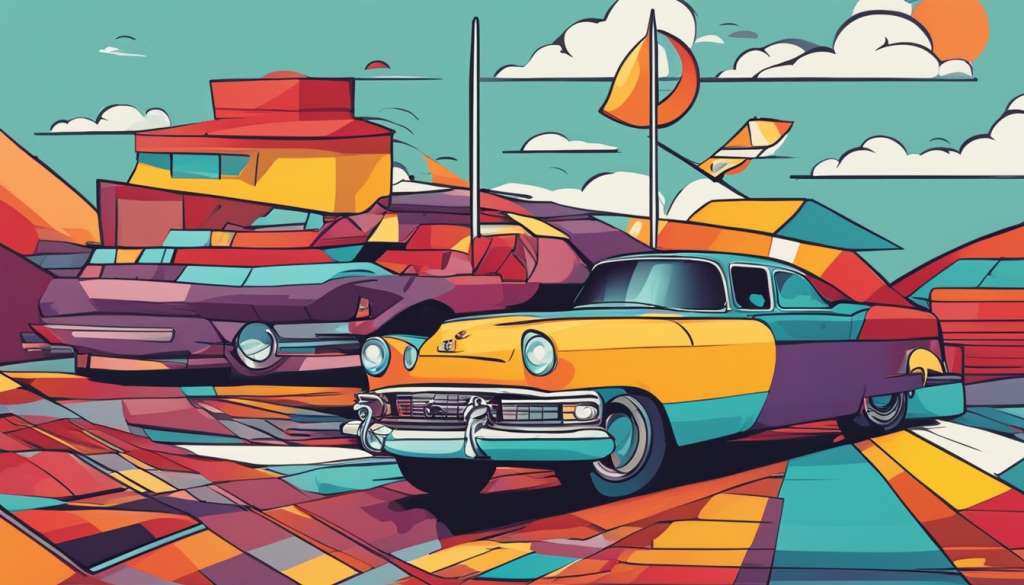Get ready to explore the exciting world of color coordination. This guide will teach you how to make designs that grab attention and inspire. You’ll learn the key skills to create stunning visuals.
Color theory is the foundation of mixing colors well. It shows how different colors work together. This knowledge lets you make color palettes that stir emotions in your audience.
The color wheel, created by Sir Isaac Newton in 1666, is still vital today. It helps you see how colors relate to each other. It’s your guide to making color schemes that look good in marketing, interior design, and more.
As you go through this guide, you’ll see how color theory can boost your projects. It doesn’t matter if you’re just starting or have years of experience. Learning about color coordination will take your work to the next level.
Understanding the Fundamentals of Color Theory
Color theory is key to visual design. It lets you create beautiful and effective color mixes. Let’s explore the main parts of this interesting field.
The Color Wheel: Your Roadmap to Harmonious Combinations
The color wheel is a visual guide for color relationships. It shows how colors work together in a circle. It’s a must-have for designers, artists, and anyone using color.
Primary, Secondary, and Tertiary Colors Explained
Colors are divided into three main groups:
- Primary colors: Red, blue, and yellow are the base of all colors.
- Secondary colors: Orange, green, and purple come from mixing two primary colors.
- Tertiary colors: These are made by mixing a primary color with a secondary color next to it.
| Color Type | Examples | How They’re Created |
|---|---|---|
| Primary | Red, Blue, Yellow | Cannot be created by mixing |
| Secondary | Orange, Green, Purple | Mixing two primary colors |
| Tertiary | Yellow-orange, Blue-green, Red-violet | Mixing a primary and adjacent secondary color |
Warm vs. Cool Colors: Setting the Mood
Colors can make us feel different things. Warm colors like reds, oranges, and yellows make us feel energetic and excited. Cool colors such as blues, greens, and purples make us feel calm and relaxed. Knowing this helps you set the right mood in your designs.
The Psychology of Color: How Hues Affect Perception and Emotion
Color psychology explores how different colors shape our thoughts, feelings, and actions. Understanding color perception gives you a powerful tool for creating impactful designs and marketing campaigns.
Every color brings out unique feelings in us. Warm colors like red and orange make us feel excited and full of energy. Think of a bright red sports car speeding by – it grabs our attention and stirs our passion.
Cool colors such as blue and green make us feel calm and peaceful. Picture a calm blue ocean – it relaxes and soothes us right away.
Designers use these effects to make visual messages that connect with people. By choosing the right colors, you can shape how people see your brand, product, or space.
| Color | Emotional Association | Common Use |
|---|---|---|
| Red | Excitement, passion | Sale signs, fast food |
| Blue | Trust, stability | Banks, tech companies |
| Green | Nature, growth | Eco-friendly brands |
| Yellow | Optimism, clarity | Warning signs, childcare |
Color psychology is not just about single colors. The way colors work together can create harmony or tension, affecting how we see things. By understanding these principles, you can improve how you communicate visually and create meaningful color experiences.
Color Coordination Guide: Principles and Techniques
Color coordination is key in design, making your work look good and effective. It’s useful for logos, websites, or interior designs. Knowing the basics can boost your design skills.
Complementary Color Schemes: Creating Dynamic Contrasts
Complementary colors are on opposite sides of the color wheel. They make bold, eye-catching contrasts. Think of blue and orange, or red and green. These pairs are great for highlighting important parts or energizing your design.
Analogous Color Schemes: Achieving Harmony and Balance
Analogous colors are right next to each other on the wheel. They bring a sense of peace and are common in nature. For example, yellow-green, yellow, and yellow-orange work well together. This is perfect for creating a smooth look in designs or branding.
Triadic Color Schemes: The Power of Three
Triadic schemes use colors equally spaced on the wheel. They mix contrast with harmony. Red, blue, and yellow are a classic triadic set. It’s great for lively designs that still feel balanced.
| Color Scheme | Characteristics | Best Used For |
|---|---|---|
| Complementary | High contrast, vibrant | Logos, call-to-action buttons |
| Analogous | Harmonious, natural | Website backgrounds, room decor |
| Triadic | Balanced, versatile | Infographics, product packaging |
Learning these color coordination methods lets you make designs that look great and get your message across. Try out different color mixes to see what suits your project best.
Mastering Monochromatic Color Schemes

Monochromatic colors make designs look elegant. You can use different tints, shades, and tones of one color. This creates a look that’s both simple and visually appealing.
Tints are made by adding white to a color. This makes the color lighter and can give your design a soft feel. Shades are created by mixing black with the color. This makes the color darker and adds depth.
Tones are made by adding gray to the color. This reduces the color’s intensity.
To use monochromatic color schemes, pick a color and try different variations. For example, with blue, you could use a light sky blue, a deep navy, and various tones in between. This adds interest while keeping the design cohesive.
| Element | Description | Effect |
|---|---|---|
| Tints | Base color + White | Lightens, adds softness |
| Shades | Base color + Black | Darkens, adds depth |
| Tones | Base color + Gray | Mutes intensity |
Monochromatic schemes don’t have to be dull. By changing the lightness, darkness, and intensity of your color, you can create a deep, sophisticated look. This method is great for many things, like decorating or graphic design.
The Role of Neutrals in Color Coordination
Neutral colors are key to a balanced color scheme. They lay the groundwork for your design, letting other colors stand out. White, black, and gray are essential neutrals, each with its own strengths.
Using White, Black, and Gray to Enhance Your Palette
White brightens spaces and makes rooms look bigger. Black adds depth and drama, perfect for striking contrasts. Gray blends well with other colors, offering a variety of tones from cool to warm.
For color balance, try the 60-30-10 rule. Use 60% of a main neutral color, 30% of a secondary color, and 10% of an accent color. This mix ensures harmony while allowing for creativity.
Earth Tones: Incorporating Natural Hues
Earth tones add warmth and comfort to your design. They include browns, tans, and muted greens, reminiscent of nature. These colors work well with neutrals, creating a calming atmosphere.
Use earth tones as accent walls or in textiles like rugs and curtains. They suit both modern and traditional spaces, adding elegance and depth.
| Neutral Color | Effect | Best Paired With |
|---|---|---|
| White | Brightens, expands | Any color |
| Black | Adds drama, depth | Bright colors, metallics |
| Gray | Balances, softens | Bold or pastel colors |
| Earth Tones | Warms, grounds | Neutrals, muted colors |
Mastering neutral colors and earth tones helps you create versatile, timeless color schemes. These will endure through the years.
Color Coordination in Interior Design
Interior color schemes are key to making your home feel just right. Paint colors can change how a room feels, affecting your mood and how you see things. Knowing about room color psychology helps you pick colors that match your design goals.
Think about the room’s size and how much natural light it gets when picking paint colors. Warm colors like reds and oranges make big rooms feel snug. Cool colors like blues and greens make small rooms look bigger. The color wheel is a great tool for finding matching colors.
Creating Harmonious Color Palettes
Here are ways to make your interior colors work well together:
- Complementary: Pair colors on opposite sides of the wheel for a strong contrast
- Analogous: Use colors next to each other for a smooth look
- Monochromatic: Try different shades of one color
Colors can make you feel certain ways. For example, yellow makes you happy, and purple feels luxurious. Think about these effects when choosing paint for your home.
| Color | Psychological Effect | Ideal Room |
|---|---|---|
| Blue | Calm, Relaxation | Bedroom |
| Green | Balance, Harmony | Living Room |
| Red | Energy, Excitement | Dining Room |
| White | Cleanliness, Spaciousness | Kitchen |
Your interior colors should show your style and make your home comfy. Try out different paint colors and mixes to find the best look for your space.
Fashion and Personal Style: Coordinating Colors in Your Wardrobe
Your wardrobe is a canvas for self-expression. Mastering color coordination lets you create outfits that show off your unique style. Let’s dive into how fashion color trends, personal color analysis, and color blocking can boost your look.
Seasonal Color Analysis: Finding Your Perfect Palette
Personal color analysis helps find colors that look good on you. It puts people into four seasons: Spring, Summer, Autumn, and Winter. Each season has colors that make your skin, eyes, and hair look great.
- Skin undertone (warm or cool)
- Natural hair color
- Eye color
- How you look in gold vs. silver jewelry
Knowing your season lets you pick clothes that flatter you and follow fashion trends.
Color Blocking: Making Bold Statements
Color blocking uses solid blocks of contrasting colors in an outfit. It makes outfits stand out and lets you express yourself boldly.
To get good at color blocking:
- Start with two colors that go well together
- Try out different color mixes
- Add neutral pieces to balance bold colors
- Think about how much of each color you use
Using these color coordination tips, you’ll make outfits that look good together. They’ll show off your style and keep you in fashion.
Digital Color Coordination: Web Design and Graphic Arts
Digital design needs careful color coordination for a great look and feel. Web color palettes are key in making websites, apps, and digital graphics look good. Learning how to coordinate colors digitally can make your designs better and help people recognize your brand.

When picking colors for the web, think about making them accessible. It’s important for text to be easy to read against the background. Use tools like contrast checkers to make sure your colors work well for everyone.
Hex codes are the way we talk about colors online. These six-digit codes help pick colors and keep them consistent everywhere. Getting to know hex codes helps you share colors clearly in your digital work.
Color Theory in Digital Design
Use color theory to make your digital designs work well. Complementary colors make things stand out, while analogous colors keep things together. Try different colors together to find the best mix for your project.
| Color Scheme | Effect | Best Use |
|---|---|---|
| Monochromatic | Clean, cohesive look | Minimalist designs, corporate sites |
| Complementary | High contrast, eye-catching | Call-to-action buttons, logos |
| Analogous | Harmonious, soothing | Blogs, wellness websites |
| Triadic | Vibrant, balanced | Creative portfolios, children’s websites |
Good digital color coordination is more than just looking good. It affects how people use your site, helps them find their way, and shares your brand’s message. By choosing and using colors wisely in your web and graphic arts, you can make digital experiences that really connect with people.
Tools and Resources for Color Coordination
Color coordination is easy with the right tools. Digital innovations have made it simple to create stunning color schemes. Let’s look at some top color tools that will improve your design work.
Color Palette Generators: Streamlining Your Design Process
Palette generators are a must-have for designers. They remove the guesswork from making color combinations that work well together. Just pick a base color, and they suggest matching hues. Coolors and Adobe Color are great options, known for their easy-to-use interfaces.
These tools also have features like color blindness simulation and accessibility checks. This makes sure your designs look good and are accessible to everyone.
Color Matching Apps: Coordination on the Go
Color matching apps let you create palettes on your smartphone. They use your camera to identify colors around you. Apps like ColorSnap and Pantone Studio are perfect for capturing inspiration anywhere.
| App Name | Key Features | Platform |
|---|---|---|
| ColorSnap | Real-time color matching, Paint suggestions | iOS, Android |
| Pantone Studio | Professional color libraries, Trend forecasts | iOS |
| Adobe Capture | Color extraction from images, Integration with Creative Cloud | iOS, Android |
With these color tools, creating stunning, coordinated designs is easy. Palette generators and color matching apps make the process simpler. This lets you focus on making your creative ideas come to life.
Conclusion: Embracing the Power of Color in Your Life and Work
Color touches every part of our lives, from what we wear to where we live. By learning about color theory and design, you can use colors to improve how you communicate visually. This is useful for designers, marketers, or anyone wanting to boost their style.
Using colors together is more than just making things look good. It helps share feelings, set moods, and change how people see things. By using color theory in your work, you can make your visuals more engaging and effective. This means picking the right colors for your home or creating eye-catching graphics becomes easier.
As you dive deeper into color, remember, practice is key. Try out different color mixes, experiment with new ones, and don’t hesitate to try new things. With more practice, you’ll get better at using colors in a way that works well for you. Embrace the colorful world and see how it changes your design and communication.

